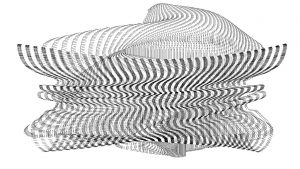I looked into artist Lia’s generative artwork on Flickr. I think she might start this drawing with lines that have thick line weights created by hatching. After arrayed several series of these lines, she might distort and bend (like these commands in Rhino), these lines to achieve visual illusion. Her work is also artistic in a way these lines create volumes and spaces. By placing series of lines together, surfaces are formed. The drawing has tight and loose parts, and the dramatic acute-angled curves bring contrast and depth. I also discovered that the hatching components of the lines differ as it moves from the tight parts to the loose parts. The asymmetrical yet symmetrical-in-part composition creates movement for this artwork, allowing audience to follow the flow of the surfaces. Her idea of creating dynamic moves by repetition corresponds to her algorithm, making it a piece of “smart” art.
Lia’s Webstie
04-Untitled 20160816
![[OLD – FALL 2016] 15-104 • COMPUTING for CREATIVE PRACTICE](https://courses.ideate.cmu.edu/15-104/f2016/wp-content/uploads/2020/08/stop-banner.png)
